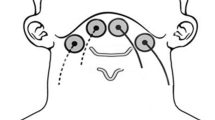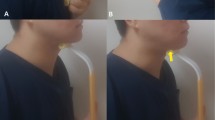Abstract
We tested the effects of surface electrical stimulation on hyoid elevation during swallowing in healthy volunteers. Sixteen people were recruited and randomly divided into two groups. Electrical stimulation was applied to the skin above the infrahyoid muscle in the experimental group. The stimulation current was adjusted until muscle contraction occurred and the hyoid bone became depressed. Participants were asked to swallow forcefully so as to elevate the hyolaryngeal complex when the stimulation began. The same experiment was performed in the control group except the intensity of stimulation was adjusted to just above the sensory threshold. The two groups received ten 20-min treatments over 2 weeks. We recorded the myoelectrical activity of the submental muscles and the amount of hyoid bone movement at three time points (pretreatment, immediately post-treatment, and 2 weeks after treatment). In the experimental group, the amount of y-axis hyoid bone excursion was increased immediately post-treatment, but this effect faded within 2 weeks following the treatment. Myoelectrical activity was not affected by either treatment regimen. We concluded that effortful swallowing coupled with electrical stimulation increases the degree of hyoid elevation in healthy volunteers. It needs to be evaluated for its long-term effectiveness in increasing the elevation of hyolaryngeal complex.



Similar content being viewed by others
References
Park CL, O’Neill PA, Martine DF. A pilot exploratory study of oral electrical stimulation on swallow function following stroke: an innovative technique. Dysphagia. 1997;12:161–6. doi:10.1007/PL00009531.
Freed ML, Freed L, Chatburn RL, Christian M. Electrical stimulation for swallowing disorders caused by stroke. Respir Care. 2001;46:466–74.
Leelamanit V, Limsakul C, Geater A. Synchronized electrical stimulation in treating pharyngeal dysphagia. Laryngoscope. 2002;112:2204–10. doi:10.1097/00005537-200212000-00015.
Blumenfeld L, Hahn Y, LePage A, Leonard R, Belafsky PC. Transcutaneous electrical stimulation versus traditional dysphagia therapy: a nonconcurrent cohort study. Otolaryngol Head Neck Surg. 2006;135:754–7. doi:10.1016/j.otohns.2006.04.016.
Shaw GY, Sechtem PR, Searl J, Keller K, Rawi TA, Dowdy E. Transcutaneous neuromuscular electrical stimulation (VitalStim) curative therapy for severe dysphagia: myth or reality? Ann Otol Rhinol Laryngol. 2007;116:36–44.
Kiger M, Brown CS, Watkins L. Dysphagia management: An analysis of patient outcomes using VitalStim therapy compared to traditional swallow therapy. Dysphagia. 2006;21:243–53. doi:10.1007/s00455-006-9056-1.
Bülow M, Speyer R, Baijens L, Woisard V, Ekberg O. Neuromuscular electrical stimulation (NMES) in stroke patients with oral and pharyngeal dysfunction. Dysphagia. 2008;23:302–9. doi:10.1007/s00455-007-9145-9.
Suiter DM, Leder SB, Ruark JL. Effects of neuromuscular electrical stimulation on submental muscle activity. Dysphagia. 2006;21:56–60. doi:10.1007/s00455-005-9010-7.
Humbert IA, Poletto CJ, Saxon KG, Kearney PR, Crujido L, Wright-Harp W, et al. The effect of surface electrical stimulation on hyo-laryngeal movement in normal individuals at rest and during swallowing. J Appl Physiol. 2006;101:1657–63. doi:10.1152/japplphysiol.00348.2006.
Ludlow CL, Humbert I, Saxon K, Poletto C, Sonies B, Crujido L. Effects of surface electrical stimulation both at rest and during swallowing in chronic pharyngeal dysphagia. Dysphagia. 2007;22:1–10. doi:10.1007/s00455-006-9029-4.
Lundy DA, Smith C, Colangelo L, Sullivan PA, Logemann JA, Lazarus CL, et al. Aspiration: cause and implications. Otolaryngol Head Neck Surg. 1999;120:474–8. doi:10.1053/hn.1999.v120.a91765.
Cook IJ, Dodds WJ, Dantas RO, Massey B, Kern MK, Lang IM, et al. Opening mechanisms of the human upper esophageal sphincter. Am J Physiol. 1989;257:G748–59.
de Lateur BJ. Therapeutic exercise. In: Braddom RL, editor. Physical medicine and rehabilitation. 2nd ed. Philadelphia: W.B. Saunders; 2000. p. 399–401.
Moritani T, de Vries HK. Neural factors versus hypertrophy in the time course of muscle strength gain. Am J Phys Med. 1979;58:115–30.
Deschenes MR, Giles JA, McCoy RW, Volek JS, Gomez AL, Kraemer WJ. Neural factors account for strength decrements observed after short-term muscle unloading. Am J Physiol Regul Integr Comp Physiol. 2002;282:R578–83.
Huckabee ML, Steele CM. An analysis of lingual contribution to submental surface electromyographic measures and pharyngeal pressure during effortful swallow. Arch Phys Med Rehabil. 2006;87:1067–72. doi:10.1016/j.apmr.2006.04.019.
Hind JA, Nicosia MA, Roecker EB, Carnes ML, Robbins J. Comparison of effortful and noneffortful swallows in healthy middle-aged and older adults. Arch Phys Med Rehabil. 2001;82:1661–5. doi:10.1053/apmr.2001.28006.
Bülow M, Olsson R, Ekberg O. Videomanometric analysis of supraglottic swallow, effortful swallow, and chin tuck in healthy volunteers. Dysphagia. 1999;14:67–72. doi:10.1007/PL00009589.
Author information
Authors and Affiliations
Corresponding author
Rights and permissions
About this article
Cite this article
Park, JW., Oh, JC., Lee, H.J. et al. Effortful Swallowing Training Coupled with Electrical Stimulation Leads to an Increase in Hyoid Elevation During Swallowing. Dysphagia 24, 296–301 (2009). https://doi.org/10.1007/s00455-008-9205-9
Received:
Accepted:
Published:
Issue Date:
DOI: https://doi.org/10.1007/s00455-008-9205-9




